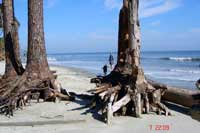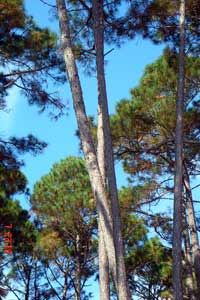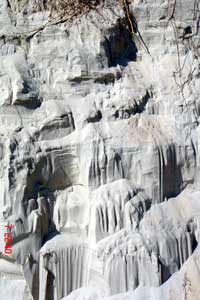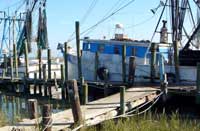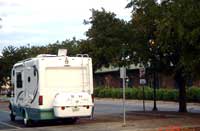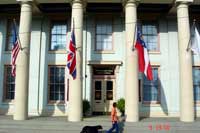

|
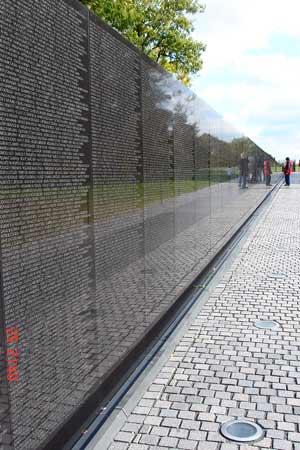 |
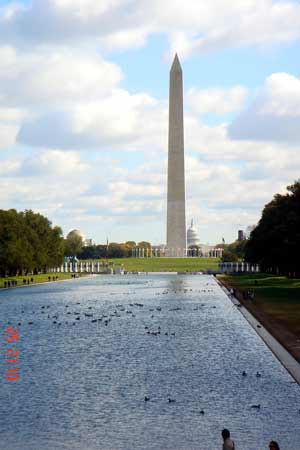 |
|---|
 Then we walked a few blocks away to the White House, which is heavily fortified now, as are many of the important government buildings, with guards and concrete barriers. Our purpose there was to go and show our support for Cindy Sheehan, whose son was killed in Iraq; she has held a vigil there for him since early September. She began her vigil at the Bush Ranch in Crawford, Texas, but after Hurricane Katrina interrupted the president*'s vacation, she followed him back to the White House and has been there ever since, with a small group of dedicated supporters. Our visit corresponded with the 2000th American soldier killed in Iraq, just the day before. This "dog and pony show", as one Republican congressman called her vigil, has been an embarrassment for the president*, which could have been avoided early on had he simply gone out and spoken to her in Crawford. But if he so carefully avoided dissenting voices on his campaign trail, why would he subject himself to them in office?
Then we walked a few blocks away to the White House, which is heavily fortified now, as are many of the important government buildings, with guards and concrete barriers. Our purpose there was to go and show our support for Cindy Sheehan, whose son was killed in Iraq; she has held a vigil there for him since early September. She began her vigil at the Bush Ranch in Crawford, Texas, but after Hurricane Katrina interrupted the president*'s vacation, she followed him back to the White House and has been there ever since, with a small group of dedicated supporters. Our visit corresponded with the 2000th American soldier killed in Iraq, just the day before. This "dog and pony show", as one Republican congressman called her vigil, has been an embarrassment for the president*, which could have been avoided early on had he simply gone out and spoken to her in Crawford. But if he so carefully avoided dissenting voices on his campaign trail, why would he subject himself to them in office?
The secret to Cindy Sheehan's appeal and power is that she's a completely normal, unpretentious person, and other normal people can see that. Her son Casey's death has given her a voice that normal people find compelling, because it's a voice just like theirs; and whose loss could have been their own. We thanked her for her courage and perseverance, and she seemed genuinely glad to meet us. To learn more about Cindy's story and current activities, go to wickipedia.org/wiki/Cindy_Sheehan
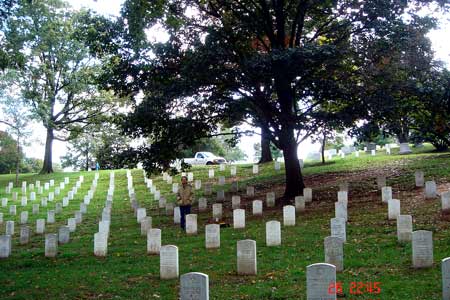
We set aside our last day in the D.C. area for a very important event: Rus' first visit to his brother's gravesite at Arlington National Cemetery. His younger brother Steve died accidentally at the age of 16, when their family lived in France, and for a mixture of reasons Rus had never visited his grave until now. It felt good sitting and talking to Steve, reconnecting with forgotten images and memories, and it brought Rus a step closer, after 40 years, toward coming to terms with his brother's death.
Next stop, Virginia
We landed that night in Virginia Beach, home of the Association for Research and Enlightenment, devoted to Edgar Cayce's teachings. Among other things, Edgar Cayce was a "medical intuitive", who received information during trance states on how to treat illnesses that had not responded to traditional medicine. His "readings", as they are called, some 15,000 of them, were all documented by his secretary, along with follow-up information from his patients as to their effectiveness. He founded a hospital in 1927 that folded in the market crash of 1929, but his son and others repurchased the property in the '50's, expanding it in the 70's to its present form. The hospital is now a center offering various treatments developed by Cayce to the public, including massage, acupressure, colonics and castor oil packs. The adjacent headquarters is a beautiful building housing, in addition to all the Cayce readings, the world's second largest metaphysical library (the largest is in the Vatican, and inaccessible to the public), as well as a visitors center, large meditation room, and a bookstore. We got the full treatment (we'll leave it to you to guess what that included) at the treatment center, slept for 12 hours, returning next day to the visitors center for a tour and a demonstration of ESP, or extra sensory perception, in which we were invited to try out our extra-sensory abilities. In one exercise, we were each given a manila envelope with a different picture inside and asked to describe the picture on a piece of paper. Of the seven of us there, one man, who'd done well on the other parts, nailed his picture exactly. It was uncanny. Lots of people think this kind of stuff is bunk, and lots of others don't. We belong to the second group.
 Then it was off to Monticello, Thomas Jefferson's home when he wasn't off founding the country or serving as Governor of Virginia, Minister to France, Secretary of State, Vice President, and President. In spite of his prodigious intellect and his social and political vision, Monticello is evidence that Jefferson may have been perfectly content just to farm his land and tinker with the many inventions his active mind conceived. The guides at the estate are very quick now to point out the inconsistencies in Jefferson's thinking, particularly the fact that he was a slave owner until the day he died, although he was morally opposed to the idea of slavery, and attempted to abolish it while president. Though much of the South's economy was predicated on slave labor for 150 years, it's difficult for us in this age to grasp the concept of owning another human being. We don't even think we "own" our dogs!
Then it was off to Monticello, Thomas Jefferson's home when he wasn't off founding the country or serving as Governor of Virginia, Minister to France, Secretary of State, Vice President, and President. In spite of his prodigious intellect and his social and political vision, Monticello is evidence that Jefferson may have been perfectly content just to farm his land and tinker with the many inventions his active mind conceived. The guides at the estate are very quick now to point out the inconsistencies in Jefferson's thinking, particularly the fact that he was a slave owner until the day he died, although he was morally opposed to the idea of slavery, and attempted to abolish it while president. Though much of the South's economy was predicated on slave labor for 150 years, it's difficult for us in this age to grasp the concept of owning another human being. We don't even think we "own" our dogs!
Jefferson died July 4, 1826, on the 50th anniversary of the signing of the Declaration of Independence. John Adams, his Federalist rival with whom he later reconciled, died the same day. Although one of Jefferson's maxims was "Don't spend money you don't have", he died over $100,000 in debt, a huge sum in those days. Montecello, it's contents, the 5,000 acre estate, including over 100 slaves, were auctioned off to pay creditors. He might be considered the Father of Deficit Spending in addition to his other parenting credits, including the likelihood of having fathered several children by one of his slaves, Sally Hemings. But even with this revision of Jeffersonian idol-worship, we think he was still a pretty cool guy. As vice president under Adams, he was instrumental in preventing a war with France which Adams and the Federalists were trying to whip up under false pretenses, lying about a fictitious event, the "XYZ Affair", to build popular support for war, and suppressing dissent under the Alien and Sedition Acts. Sound at all familiar?
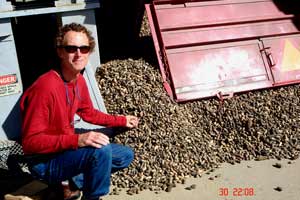 |
|
|---|
To the Beautiful Carolina Coasts
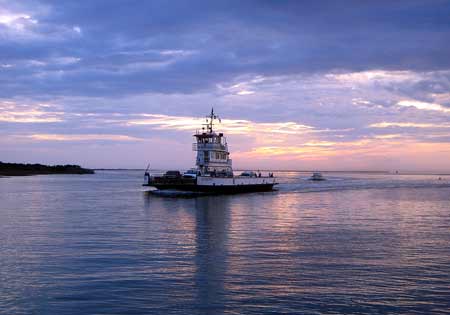 Off to the Outer Banks of North Carolina, a place of Rus' boyhood fantasies, when he read everything by Robert Ruark he could get his hands on. Surf fishing was high on the agenda, images of 5 lb bluefish dancing in his head. Well, in the 45 years since, the North Carolina coast, and especially the Outer Banks, have been discovered, rediscovered, developed and redeveloped. Driving along the Banks, through mile after mile of tacky summer rentals built right on the beach and 5 or 6 lots back, fast food franchises, and dozens of stores selling nothing but inflatable water toys and folding chairs, we knew we were too late. We met people who'd sold property just the year before, kicking themselves that they hadn't waited another year and doubled their money. Rus was disappointed. Still, we got out and walked those long stretches of sand between the waves and the rental houses. Nothing like the wild northern California beaches we are used to, there was still fine white sand, gentle blue waves, sunshine aplenty and people fishing in the surf looking mighty content to be there.
Off to the Outer Banks of North Carolina, a place of Rus' boyhood fantasies, when he read everything by Robert Ruark he could get his hands on. Surf fishing was high on the agenda, images of 5 lb bluefish dancing in his head. Well, in the 45 years since, the North Carolina coast, and especially the Outer Banks, have been discovered, rediscovered, developed and redeveloped. Driving along the Banks, through mile after mile of tacky summer rentals built right on the beach and 5 or 6 lots back, fast food franchises, and dozens of stores selling nothing but inflatable water toys and folding chairs, we knew we were too late. We met people who'd sold property just the year before, kicking themselves that they hadn't waited another year and doubled their money. Rus was disappointed. Still, we got out and walked those long stretches of sand between the waves and the rental houses. Nothing like the wild northern California beaches we are used to, there was still fine white sand, gentle blue waves, sunshine aplenty and people fishing in the surf looking mighty content to be there.
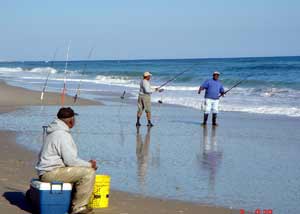 In the rare stretches protected from resort sprawl, the country is indescribably beautiful; pristine beaches on the Atlantic side, the Pamlico sound and its salt marshes to the East. The Outer Banks have a rich history, starting with Roanoke Island, Sir Walter Raleigh's first attempt at a permanent British settlement in the New World. One hundred and ten men, women and children vanished without a trace in 1587, including Virginia Dare, the first English child born in America. The pirate Blackbeard operated out of the Outer Banks for years, until he was finally defeated by a British frigate. Blackbeard's body is buried there somewhere, but his head made one final journey, tied to the bowsprit of the frigate. Then there's Kitty Hawk, where Orville and Wilbur Wright made their historic flight in 1903. They said they'd seen so many of the best minds try and fail, they figured they had about as much chance as anyone to get a machine in the air. The Outer Banks have also been named the Graveyard of the Atlantic; more than 600 ships have wrecked there in the shallow shoals, or sunk in battles. Pirates used to tie lanterns to the necks of horses tethered on the beach to simulate the motion of a ship's lantern, luring unsuspecting ships to run aground on the shoals, hence the name Nag's Head. And during WWII, German U-boats patrolling offshore sank so many of our tankers and cargo ships that the Outer Banks gained the name "Torpedo Junction". Some Germans captured there had American goods among their possessions, evidence that they'd even come ashore and gone shopping! This was all fascinating stuff to us, enough to take our minds off the obscene development along this unique and lovely shoreline. It's all just one big hurricane away from a clean slate, though.
In the rare stretches protected from resort sprawl, the country is indescribably beautiful; pristine beaches on the Atlantic side, the Pamlico sound and its salt marshes to the East. The Outer Banks have a rich history, starting with Roanoke Island, Sir Walter Raleigh's first attempt at a permanent British settlement in the New World. One hundred and ten men, women and children vanished without a trace in 1587, including Virginia Dare, the first English child born in America. The pirate Blackbeard operated out of the Outer Banks for years, until he was finally defeated by a British frigate. Blackbeard's body is buried there somewhere, but his head made one final journey, tied to the bowsprit of the frigate. Then there's Kitty Hawk, where Orville and Wilbur Wright made their historic flight in 1903. They said they'd seen so many of the best minds try and fail, they figured they had about as much chance as anyone to get a machine in the air. The Outer Banks have also been named the Graveyard of the Atlantic; more than 600 ships have wrecked there in the shallow shoals, or sunk in battles. Pirates used to tie lanterns to the necks of horses tethered on the beach to simulate the motion of a ship's lantern, luring unsuspecting ships to run aground on the shoals, hence the name Nag's Head. And during WWII, German U-boats patrolling offshore sank so many of our tankers and cargo ships that the Outer Banks gained the name "Torpedo Junction". Some Germans captured there had American goods among their possessions, evidence that they'd even come ashore and gone shopping! This was all fascinating stuff to us, enough to take our minds off the obscene development along this unique and lovely shoreline. It's all just one big hurricane away from a clean slate, though.
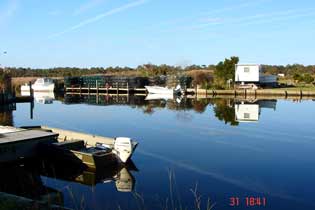 |
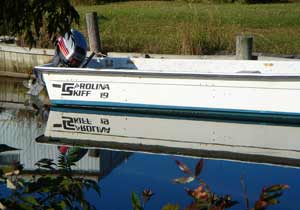 |
|---|
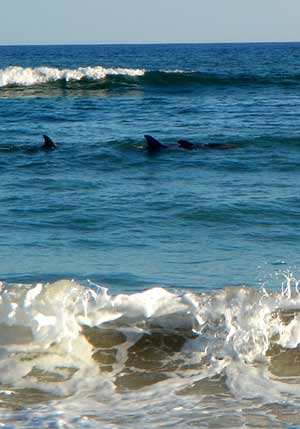 Taking a ferry from Ocracoke Island back to the mainland, we were relieved to see real towns again with diverse economies, and older homes whose owners actually lived in them. We loved the town of Beaufort and its much larger neighbor Morehead City, where we ate at the famous Sanitary Seafood Market and Restaurant, with the admonishment "We'd rather have one sober customer than a hundred drunk ones." Kathleen tried her first hush puppy there, and Rus polished off the rest (they're delicious, but only if you like them).
Taking a ferry from Ocracoke Island back to the mainland, we were relieved to see real towns again with diverse economies, and older homes whose owners actually lived in them. We loved the town of Beaufort and its much larger neighbor Morehead City, where we ate at the famous Sanitary Seafood Market and Restaurant, with the admonishment "We'd rather have one sober customer than a hundred drunk ones." Kathleen tried her first hush puppy there, and Rus polished off the rest (they're delicious, but only if you like them).
Outside Surf City we parked along the beach to walk the dogs, and while watching some surf fishermen, we were treated to an amazing display of dolphin acrobatics. Kathleen spotted 3 dorsal fins in the water, then more, as they moved in closer to shore. About 100 feet in front of us, just beyond the surf, at least 2 dozen bottlenose dolphins began their show, just like they were on the Marine World payroll. Over and over again, they leapt high out of the water, sometimes in tandem, sometimes even crossing in mid air, and surfed the waves side by side in twos and threes. Some left and moved farther out to fish, thrashing the water with their tails, then come back to play some more. The performance lasted 15 or 20 minutes, leaving us exhilarated and speechless. Afterward, we turned to one of the fishermen and said, "That was quite a show!" He said, "I been fishin' here all my life, and I never seen nothin' like it". It made Rus want to be a dolphin, and he might go for it if he gets the chance, especially if Kathleen could be one, too.
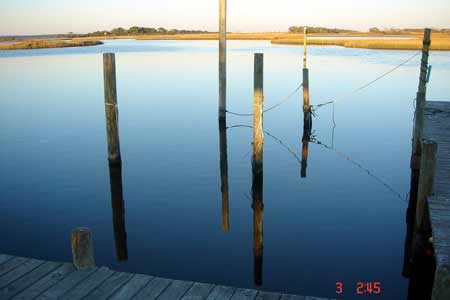 In Surf City we bought some flounder and scallops at a dockside market selling fish out of ice chests, so fresh they could have been resuscitated, then continued south to Wilmington, the largest city in North Carolina, big enough even to have a co-op and a yoga studio, both in the same building. We expect to see Wal-Marts; we don't expect to see co-ops and yoga studios. We were surprised to see ale and goat cheese there from our home town, 3,000 miles away.
In Surf City we bought some flounder and scallops at a dockside market selling fish out of ice chests, so fresh they could have been resuscitated, then continued south to Wilmington, the largest city in North Carolina, big enough even to have a co-op and a yoga studio, both in the same building. We expect to see Wal-Marts; we don't expect to see co-ops and yoga studios. We were surprised to see ale and goat cheese there from our home town, 3,000 miles away.
 From Wilmington south it's pretty much solid beachfront resorts, all the way through Myrtle Beach, South Carolina. We blew through it until we reached beautiful Huntington Beach State Park, with miles of open beaches and dunes, live oak and pine forests, and vast marshes with signs saying don't feed the alligators. We didn't let Ziggy swim there. We did try our hand at surf fishing, pole in the sand the way the locals do it, beach chair and all. Kathleen caught a flounder and had a surprise but brief visit from a beautiful little dogfish.
From Wilmington south it's pretty much solid beachfront resorts, all the way through Myrtle Beach, South Carolina. We blew through it until we reached beautiful Huntington Beach State Park, with miles of open beaches and dunes, live oak and pine forests, and vast marshes with signs saying don't feed the alligators. We didn't let Ziggy swim there. We did try our hand at surf fishing, pole in the sand the way the locals do it, beach chair and all. Kathleen caught a flounder and had a surprise but brief visit from a beautiful little dogfish.
 So what's up with South Carolina? The people we've met are bright and friendly, they all drive new cars on well-maintained roads, their dogs are spoiled rotten, the towns are prosperous, and the country is gorgeous. What's going on here? We spent a day in beautiful Charleston, aptly named for King Charles II, who is remembered for his generosity granting land in the New World to his favored subjects. The fact that this land had been occupied for centuries by other people with a highly developed civilization seems not to have troubled him.
So what's up with South Carolina? The people we've met are bright and friendly, they all drive new cars on well-maintained roads, their dogs are spoiled rotten, the towns are prosperous, and the country is gorgeous. What's going on here? We spent a day in beautiful Charleston, aptly named for King Charles II, who is remembered for his generosity granting land in the New World to his favored subjects. The fact that this land had been occupied for centuries by other people with a highly developed civilization seems not to have troubled him.
 Satiated with historical architecture after Charleston, we wandered accidentally into a magical place to camp, Hunting Beach State Park, on the south coast of South Carolina. Set in a dense forest of palmetto, pine and live oak, this park is a remnant of what the South Carolina coast must have been like centuries ago, before the deforestation by Europeans. We were glad to be able to see it when we did, though, because the ocean is making some serious inroads on this little island, helped by the recent hurricanes. Downed trees line the shore, remnants of roads and utility lines lead nowhere. We talked to a woman who has been coming here since she was a girl; her favorite campsites are now out in the ocean.
Satiated with historical architecture after Charleston, we wandered accidentally into a magical place to camp, Hunting Beach State Park, on the south coast of South Carolina. Set in a dense forest of palmetto, pine and live oak, this park is a remnant of what the South Carolina coast must have been like centuries ago, before the deforestation by Europeans. We were glad to be able to see it when we did, though, because the ocean is making some serious inroads on this little island, helped by the recent hurricanes. Downed trees line the shore, remnants of roads and utility lines lead nowhere. We talked to a woman who has been coming here since she was a girl; her favorite campsites are now out in the ocean.
In the morning we met a couple, Fred and Robin, who recommended we stop in Savannah, GA on our way south. We were kind of up to here with touristy historical stuff, but they said Savannah was a town that could handle it's own heritage without being dominated by it, and was just a great town to go visit, and gave us lots of tips. They even invited us to come visit them at their farm in Tennessee, which we did several weeks later.

This tells the story of the erosion going on in the barrier islands, especially Hunting Is

And finally, Georgia
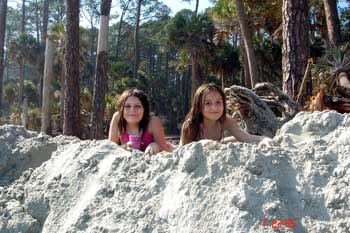 Turned out they were right, and we spent a couple of fine days in Savannah just hanging out, our rig parked in the visitors center parking lot, everything within walking distance. For many years Savannah was the center of the cotton trade; most of the cotton bound for the world's textile mills was shipped from its deepwater port, and the riverfront is still lined with the brick and stone buildings which housed the old cotton merchant offices, some restored and others not. The old streets are still paved with ballast stones from the ships arriving there from distant ports.
Turned out they were right, and we spent a couple of fine days in Savannah just hanging out, our rig parked in the visitors center parking lot, everything within walking distance. For many years Savannah was the center of the cotton trade; most of the cotton bound for the world's textile mills was shipped from its deepwater port, and the riverfront is still lined with the brick and stone buildings which housed the old cotton merchant offices, some restored and others not. The old streets are still paved with ballast stones from the ships arriving there from distant ports.

Today, the Savannah College of Art and Design, or SCAD, gives a youthful, creative energy to the city. SCAD doesn't have a central campus; instead, it occupies many old buildings throughout the historical district which the college purchased in the '70s and restored. Through their foresight many fine old buildings were saved from becoming parking garages or concrete government buildings. An additional benefit is that the students are part of the community, and not isolated on a central campus as they usually are. And, at $20,000 tuition a year, plus room and board, times 3500 students or so, that can't hurt the local economy.
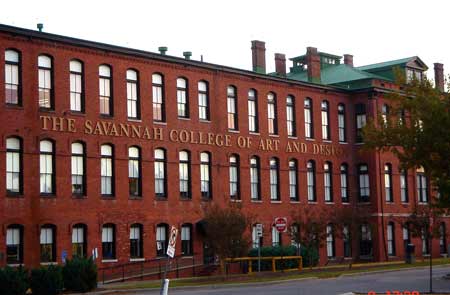 |
|---|
Savannah was good to us. We saw the Maxfield Parrish show at the Telfaire museum with paintings in glorious color, the size of entire walls. We ate well, walked all over town by day and spent several hours listening to a great pair of musicians along the waterfront by night. These guys loved to play and sing, especially together. One guy with a deep bass voice and a full white beard sat on the bench staring off into space like he wasn't part of the gig, yet somehow you suspected he was. At some some unseen inspiration he would spring up into a syncopated, choreographed song and dance routine and add his voice in rhythm and harmony to the lead singer/guitar player's. People joined in singing at times, some danced. One by one, every singer in the crowd got invited up to do a number, including Rus. What a warm and lively night under the Savannah sky. We walked back to the rig and slept soundly in our nest in the parking lot by the visitor's center.
Links |
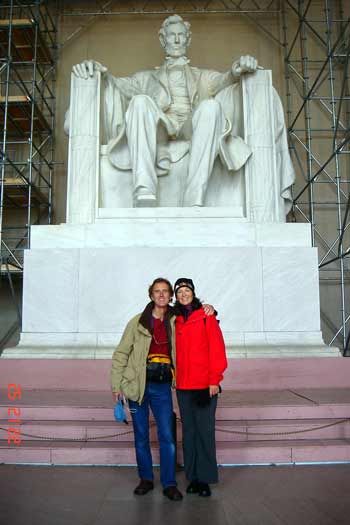

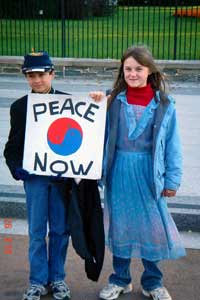

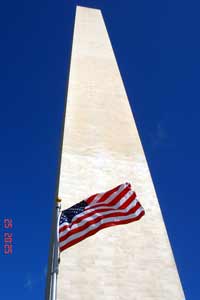
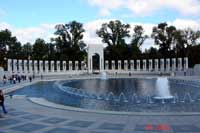


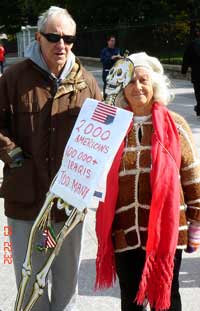


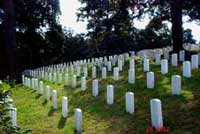




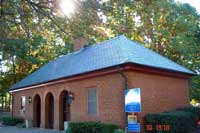

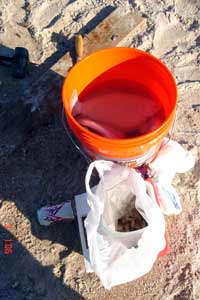
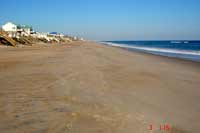
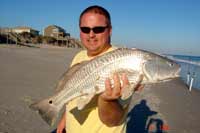
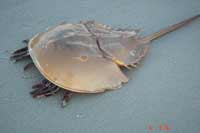
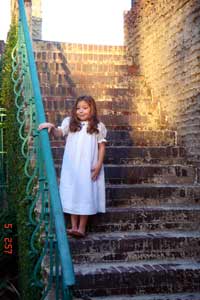
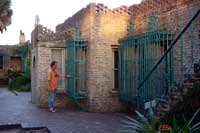 , Atalaya, Huntington Beach State Park, SC
, Atalaya, Huntington Beach State Park, SC 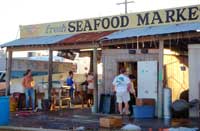
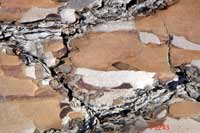
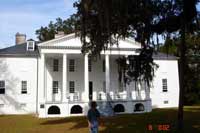
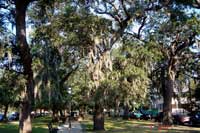 Charleston Trees
Charleston Trees 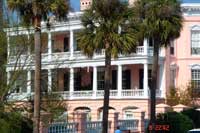
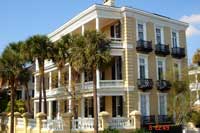

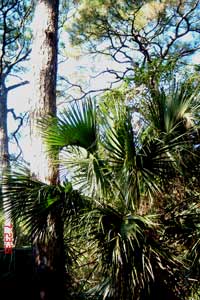
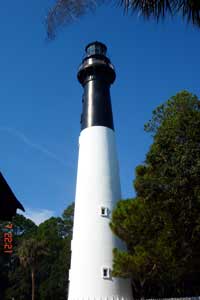
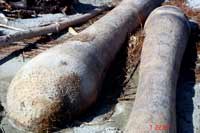
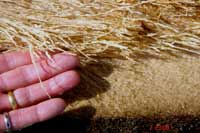 Fibers in the palm stumps scattered along the beach, above
Fibers in the palm stumps scattered along the beach, above